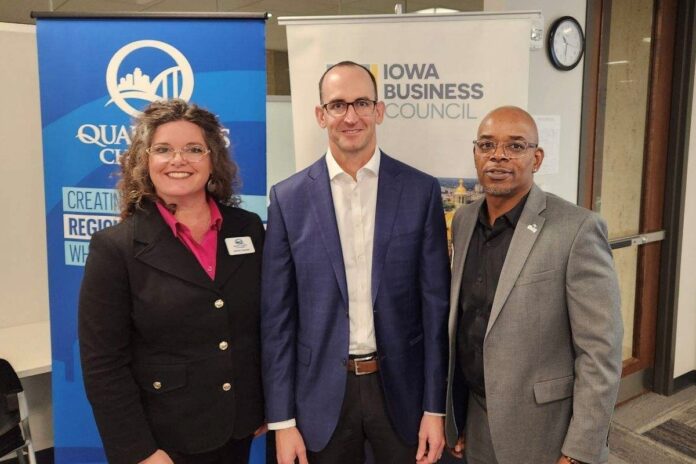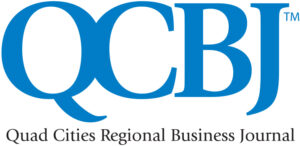
Even as multiple existing businesses are or will be expanding their Quad Cities operations, the region’s lack of construction-ready sites continues to challenge efforts by the Quad Cities Chamber and others to lure new major manufacturers to the region. Those were among the key takeaways from a lively presentation hosted recently by the Rotary Club […]
Already a subscriber? Log in
Want to Read More?
Get immediate, unlimited access to all subscriber content and much more.
Learn more in our subscriber FAQ.
- Unparalleled business coverage of the Quad Cities
- Immediate access to subscriber-only content on our website.
- 52 issues per year delivered digitally, in print or both.
- Support locally owned and operated journalism.
Do you want to read and share this article without a paywall?
Click here to purchase a paywall bypass linkEven as multiple existing businesses are or will be expanding their Quad Cities operations, the region’s lack of construction-ready sites continues to challenge efforts by the Quad Cities Chamber and others to lure new major manufacturers to the region.
 Those were among the key takeaways from a lively presentation hosted recently by the Rotary Club of Rock Island. It featured Chris Caves, vice president, business retention & expansion, workforce, for the regional chamber of commerce.
The primary focus of Ms. Cave’s small chamber team is business retention and expansion and she’s proud to report that despite challenges such as workforce downsizing at John Deere that also impacts local suppliers, many Quad Cities manufacturers are expanding their local footprint.
That’s critical, the award-winning economic development consultant told Rotarians late last month because “80% of business growth happens with existing companies. We want to get more companies who want to expand their footprint.”
Through her work, Ms. Caves sits down with some 130 manufactures a year throughout the six-county, bi-state region. Among the things they talk about are: How are your markets? What are your plans for expansion? Who's investing in automation? What’s your workforce profile look like? What are your supply chains? Are there any challenges with community services?
“It’s a great conversation and I’m privileged to be able to do that,” she said. “What I find out is, No. 1, many of these companies are interested in adopting automated technologies. It isn’t to displace a single worker, it's actually to add proficiency, productivity to their operations.”
Many already are doing that on their own factory floors, she said, to improve efficiency and “run better, smarter, leaner.”
Those were among the key takeaways from a lively presentation hosted recently by the Rotary Club of Rock Island. It featured Chris Caves, vice president, business retention & expansion, workforce, for the regional chamber of commerce.
The primary focus of Ms. Cave’s small chamber team is business retention and expansion and she’s proud to report that despite challenges such as workforce downsizing at John Deere that also impacts local suppliers, many Quad Cities manufacturers are expanding their local footprint.
That’s critical, the award-winning economic development consultant told Rotarians late last month because “80% of business growth happens with existing companies. We want to get more companies who want to expand their footprint.”
Through her work, Ms. Caves sits down with some 130 manufactures a year throughout the six-county, bi-state region. Among the things they talk about are: How are your markets? What are your plans for expansion? Who's investing in automation? What’s your workforce profile look like? What are your supply chains? Are there any challenges with community services?
“It’s a great conversation and I’m privileged to be able to do that,” she said. “What I find out is, No. 1, many of these companies are interested in adopting automated technologies. It isn’t to displace a single worker, it's actually to add proficiency, productivity to their operations.”
Many already are doing that on their own factory floors, she said, to improve efficiency and “run better, smarter, leaner.”
 Those were among the key takeaways from a lively presentation hosted recently by the Rotary Club of Rock Island. It featured Chris Caves, vice president, business retention & expansion, workforce, for the regional chamber of commerce.
The primary focus of Ms. Cave’s small chamber team is business retention and expansion and she’s proud to report that despite challenges such as workforce downsizing at John Deere that also impacts local suppliers, many Quad Cities manufacturers are expanding their local footprint.
That’s critical, the award-winning economic development consultant told Rotarians late last month because “80% of business growth happens with existing companies. We want to get more companies who want to expand their footprint.”
Through her work, Ms. Caves sits down with some 130 manufactures a year throughout the six-county, bi-state region. Among the things they talk about are: How are your markets? What are your plans for expansion? Who's investing in automation? What’s your workforce profile look like? What are your supply chains? Are there any challenges with community services?
“It’s a great conversation and I’m privileged to be able to do that,” she said. “What I find out is, No. 1, many of these companies are interested in adopting automated technologies. It isn’t to displace a single worker, it's actually to add proficiency, productivity to their operations.”
Many already are doing that on their own factory floors, she said, to improve efficiency and “run better, smarter, leaner.”
Those were among the key takeaways from a lively presentation hosted recently by the Rotary Club of Rock Island. It featured Chris Caves, vice president, business retention & expansion, workforce, for the regional chamber of commerce.
The primary focus of Ms. Cave’s small chamber team is business retention and expansion and she’s proud to report that despite challenges such as workforce downsizing at John Deere that also impacts local suppliers, many Quad Cities manufacturers are expanding their local footprint.
That’s critical, the award-winning economic development consultant told Rotarians late last month because “80% of business growth happens with existing companies. We want to get more companies who want to expand their footprint.”
Through her work, Ms. Caves sits down with some 130 manufactures a year throughout the six-county, bi-state region. Among the things they talk about are: How are your markets? What are your plans for expansion? Who's investing in automation? What’s your workforce profile look like? What are your supply chains? Are there any challenges with community services?
“It’s a great conversation and I’m privileged to be able to do that,” she said. “What I find out is, No. 1, many of these companies are interested in adopting automated technologies. It isn’t to displace a single worker, it's actually to add proficiency, productivity to their operations.”
Many already are doing that on their own factory floors, she said, to improve efficiency and “run better, smarter, leaner.”




